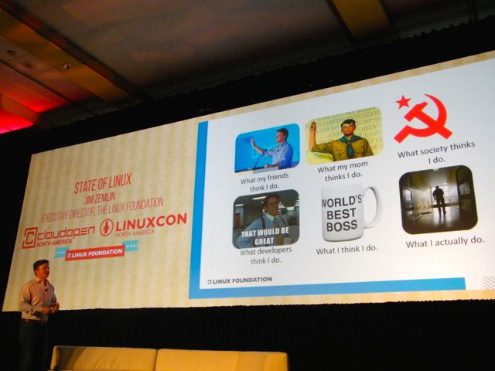CHICAGO – Jim Zemlin, the executive director of the Linux Foundation, talks about Linux a lot. During his keynote at the LinuxCon USA event here, Zemlin noted that it’s often difficult for him to come up with new material for talking about the state of Linux at this point.
Every year at LinuxCon, Zemlin delivers his State of Linux address, but this time he took a different approach. Zemlin detailed what he actually does and how the Linux Foundation works to advance the state of Linux.
Fundamentally it’s all about enabling the open source collaboration model for software development.
“We are seeing a shift now where the majority of code in any product or service is going to be open source,” Zemlin said.
Zemlin added that open source is the new Pareto Principle for software development, where 80 percent of software code is open source. The nature of collaborative development itself has changed in recent years. For years the software collaboration was achieved mostly through standards organizations.
“Today open source is becoming the dominant form of collaboration in the industry and often open source projects lead standards efforts,” Zemlin said “Open source is becoming the new way to enable the tech industry to provide 80 percent of the code that goes into the things that are part of our life.”
Zemlin said that he used to always introduce himself as Linus Torvalds’ boss, but that’s not really what he does. Really what Zemlin and the Linux Foundation does is keep things clean so development can work.
“I’m just Linus Torvalds’ janitor,” Zemlin said.
What the Linux Foundation provides is a structure that helps industry at large understand open source. Zemlin said that the Foundation teaches open source basics and enables open source development in business processes. The Foundation also works to develop relationships between industry and community and demonstrates business value in community support.
The Foundation also provides shared development infrastructure, including code review processes, shared testing infrastructure and release management capabilities. Zemlin said that Linux has moved from an adhoc society to a professionally organized group.
The Foundation is also able to step in and help address market failures, such at the one that occurred early this year with the OpenSSL heartbleed security flaw. In the wake of Heartbleed, the Linux Foundation launched the Core Infrastructure Initiative and raised millions to help provide additional resources to open-source projects like OpenSSL.
Another key part of the Linux Foundation’s activities is bringing in more developers as well as marketing. Zemlin stressed that marketing matters even in open source.
The Foundation also allows for shared intellectual property management and legal defense.
“It’s about keeping the halls clean,” Zemlin said. “Let the coding happen by teaching lawyers how to enable engineers instead of restricting them.”

Jim Zemlin, executive director of the Linux Foundation
Sean Michael Kerner is a senior editor at Datamation and InternetNews.com. Follow him on Twitter @TechJournalist
Huawei’s AI Update: Things Are Moving Faster Than We Think
FEATURE | By Rob Enderle,
December 04, 2020
Keeping Machine Learning Algorithms Honest in the ‘Ethics-First’ Era
ARTIFICIAL INTELLIGENCE | By Guest Author,
November 18, 2020
Key Trends in Chatbots and RPA
FEATURE | By Guest Author,
November 10, 2020
FEATURE | By Samuel Greengard,
November 05, 2020
ARTIFICIAL INTELLIGENCE | By Guest Author,
November 02, 2020
How Intel’s Work With Autonomous Cars Could Redefine General Purpose AI
ARTIFICIAL INTELLIGENCE | By Rob Enderle,
October 29, 2020
Dell Technologies World: Weaving Together Human And Machine Interaction For AI And Robotics
ARTIFICIAL INTELLIGENCE | By Rob Enderle,
October 23, 2020
The Super Moderator, or How IBM Project Debater Could Save Social Media
FEATURE | By Rob Enderle,
October 16, 2020
FEATURE | By Cynthia Harvey,
October 07, 2020
ARTIFICIAL INTELLIGENCE | By Guest Author,
October 05, 2020
CIOs Discuss the Promise of AI and Data Science
FEATURE | By Guest Author,
September 25, 2020
Microsoft Is Building An AI Product That Could Predict The Future
FEATURE | By Rob Enderle,
September 25, 2020
Top 10 Machine Learning Companies 2020
FEATURE | By Cynthia Harvey,
September 22, 2020
NVIDIA and ARM: Massively Changing The AI Landscape
ARTIFICIAL INTELLIGENCE | By Rob Enderle,
September 18, 2020
Continuous Intelligence: Expert Discussion [Video and Podcast]
ARTIFICIAL INTELLIGENCE | By James Maguire,
September 14, 2020
Artificial Intelligence: Governance and Ethics [Video]
ARTIFICIAL INTELLIGENCE | By James Maguire,
September 13, 2020
IBM Watson At The US Open: Showcasing The Power Of A Mature Enterprise-Class AI
FEATURE | By Rob Enderle,
September 11, 2020
Artificial Intelligence: Perception vs. Reality
FEATURE | By James Maguire,
September 09, 2020
Anticipating The Coming Wave Of AI Enhanced PCs
FEATURE | By Rob Enderle,
September 05, 2020
The Critical Nature Of IBM’s NLP (Natural Language Processing) Effort
ARTIFICIAL INTELLIGENCE | By Rob Enderle,
August 14, 2020

Datamation is the leading industry resource for B2B data professionals and technology buyers. Datamation's focus is on providing insight into the latest trends and innovation in AI, data security, big data, and more, along with in-depth product recommendations and comparisons. More than 1.7M users gain insight and guidance from Datamation every year.
Advertise with TechnologyAdvice on Datamation and our other data and technology-focused platforms.
Advertise with Us
Property of TechnologyAdvice.
© 2025 TechnologyAdvice. All Rights Reserved
Advertiser Disclosure: Some of the products that appear on this
site are from companies from which TechnologyAdvice receives
compensation. This compensation may impact how and where products
appear on this site including, for example, the order in which
they appear. TechnologyAdvice does not include all companies
or all types of products available in the marketplace.